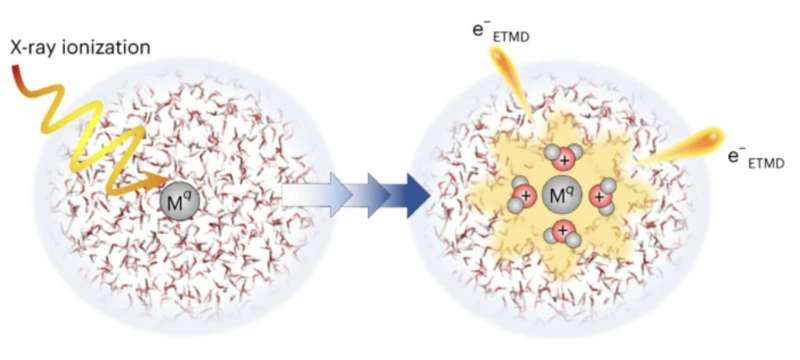This article has been reviewed according to Science X's editorial process and policies. Editors have highlighted the following attributes while ensuring the content's credibility:
fact-checked
peer-reviewed publication
trusted source
proofread
Radiation damage mechanisms: Study shows water ionization hot-spots form around solvated metal ions

A new international study, has revealed insights into the mechanisms underlying radiation damage at the molecular level. The research, published in Nature Chemistry, reveals how extensive, localized water ionization occurs due to the ultrafast processes triggered by core-level ionization of solvated metal ions.
Radiation damage, particularly in biological systems, is primarily driven by the ionization of water molecules and the subsequent formation of radicals and low-energy electrons. Instead of directly ionizing biomolecules, this research demonstrates that the initiation of radiation damage is closely linked to solvated metal ions in water. This is a departure from previous theories that attributed radiation damage mainly to random events along the radiation path.
"A few years ago it was theoretically predicted that when X-rays are applied to magnesium ions, highly ionized and excited states can be formed, but they quickly relax with the help of surrounding water molecules, thus ionizing them," says Eva Muchová from the University of Chemistry and Technology in Prague.
"In our publication, we demonstrate the detailed multi-step mechanism by which relaxation occurs using the example of solvated aluminum ions. It is clear that the relaxation of ions causes extensive and very localized ionization of water and we can talk about the formation of so-called 'hot-spots' of radiation damage," she adds.
The study specifically investigated the behavior of Al3+ ions in aqueous solutions after core-level ionization. It was found that electronic relaxation in these systems involves two sequential solute-solvent electron transfer-mediated decay processes.
According to Eva Muchová, the corresponding author of the study, "The electron transfer-mediated decay steps correspond to sequential relaxation from Al5+ to Al3+ accompanied by formation of four ionized water molecules and two low-energy electrons. Such charge multiplication and the generated highly reactive species are expected to initiate cascades of radical reactions."
The implications of this research are far-reaching, particularly in the context of radiation therapy for cancer treatment, where understanding radiation damage mechanisms is crucial for optimizing treatment strategies. Additionally, this research could lead to new insights into the repair of DNA molecules and contribute to the development of more efficient radiation protection measures in various fields.
The study combined advanced experimental techniques, including liquid-jet photoemission spectroscopy, with high-level ab initio calculations to confirm the occurrence of these complex processes. The researchers emphasized that this work represents a significant step forward in our understanding of radiation damage at the molecular level and highlights the role of solvated metal ions in initiating these processes.
More information: G. Gopakumar et al, Radiation damage by extensive local water ionization from two-step electron-transfer-mediated decay of solvated ions, Nature Chemistry (2023). DOI: 10.1038/s41557-023-01302-1
Journal information: Nature Chemistry
Provided by University of Chemistry and Technology Prague





















